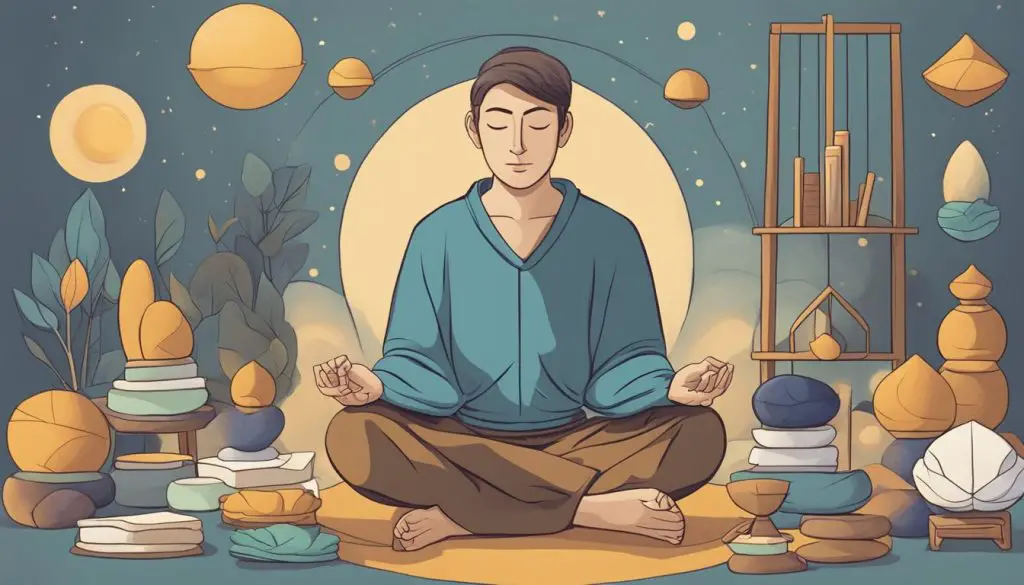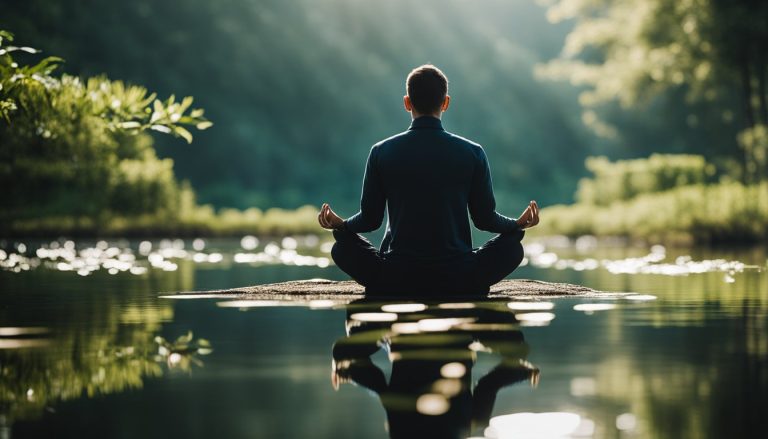How Do I Find the Right Meditation for Me? Simple Steps to Your Perfect Practice
Finding the right meditation practice might sometimes feel like navigating through a maze with countless paths, each promising a peaceful sanctuary.
With so many styles and techniques, from mindfulness to breath meditation, it can be overwhelming to pinpoint where to begin.
The key is understanding that meditation is deeply personal, and what works for one person may not resonate with another.
My journey started with curiosity and a desire to cultivate calmness and focus in my bustling life.

Exploring various meditation techniques was an enlightening process that allowed me to connect with my inner self on a deeper level.
It wasn’t just about sitting in silence; it was about discovering practices that aligned with my needs and lifestyle.
Whether I had ten minutes or an hour, I realized the versatility of meditation could seamlessly integrate into my daily routine.
In trying out different methods, I learned to listen to my body and mind, differentiating between what felt forced and what genuinely brought a sense of tranquility.
Key Points
- Meditation is a personalized practice, suitable for varying individual needs and preferences.
- Regular meditation fosters a sense of peace, enhancing focus and calmness in daily life.
- Finding the ideal meditation practice involves trial and reflection, leading to its seamless integration into your routine.
Table of Contents
Understanding Meditation
In my journey to find the right meditation, I’ve come to understand it’s about discovering a personal practice that aligns with my individual needs.
The benefits of meditation are vast, and various types can cater to different goals, whether that’s mindfulness, fostering a greater sense of awareness, or improving my overall health.
Benefits of Meditation
I’ve noticed that incorporating meditation into my routine offers a multitude of benefits. Importantly, these advantages stretch across mental, physical, and emotional health:
- Mental Health: Meditation helps in reducing stress and anxiety. Regular practice promotes clearer thinking and improves concentration.
- Physical Health: Studies have shown that meditation can lower blood pressure, reduce chronic pain, and improve sleep.
- Emotional Health: By fostering a deeper awareness of my emotions, meditation allows me to handle life’s challenges with greater calm and resilience.
Types of Meditation
Meditation is not a one-size-fits-all practice. Here are some common types I’ve come across:
- Mindfulness Meditation: Involves paying attention to thoughts as they pass through my mind, acknowledging them without judgment.
- Spiritual Meditation: This type can be connected with a religious practice or simply a deeper sense of connection and meaning.
- Focused Meditation: I use a focus object like a sound, image, or my breath to anchor my attention.
- Movement Meditation: Practices such as Tai Chi or yoga combine movement with meditative focus, great for someone like me who prefers an active form.
Mindfulness and Awareness
For me, mindfulness is the heart of meditation. It’s about being present in the moment, consciously aware of my experience without reaction or judgment.
Awareness, on the other hand, is the broader context in which I notice not only my immediate experiences but my patterns of thought and behavior over time.
Mindfulness meditation is a powerful tool for building this level of awareness, helping me to become more attuned to the subtleties of my mental and emotional landscape.
Getting Started with Meditation
When I decided to begin meditating, I realized it was about finding a practice that suited me personally. It involved understanding the basics, establishing a comfortable posture, and learning to guide my breath and focus.
Meditation for Beginners
For us beginners, starting a meditation practice can seem daunting at first.
I recommend starting with short, daily sessions. Five minutes a day is a good beginning, gradually increasing the time as I become more comfortable.
Choosing a specific time and quiet location helps me make meditation a part of my routine.
I also like to keep my expectations realistic; it’s okay if my mind wanders, as this is normal. The key is gently returning my focus back to the meditation without judgment.
Finding a Comfortable Position
Finding a comfortable position is crucial for me because discomfort can distract from the meditation.
I can sit on a cushion, chair, or even lie down, as long as my back is straight.
It’s important for my hands to rest comfortably, usually on my knees or in my lap.
Here’s a basic checklist to ensure comfort during meditation:
- Back straight: this supports alertness.
- Shoulders relaxed: helps prevent tension.
- Hands resting: on knees or in my lap, whichever feels more natural.
- Jaw and face relaxed: to avoid creating tension that can distract.
Breath and Focused Techniques
Breath meditation is a common focused meditation technique.
By paying attention to my breath — noticing when I take deep breaths in and gently release them out — I can anchor my focus and cultivate calm.
A simple method is counting breaths, where I count “one” as I inhale, “two” as I exhale, and so on up to ten, then begin again.
This practice keeps my concentration sharp and helps in relaxing any tension I might be holding. It brings me into the present and allows me to engage more deeply with the practice.
Exploring Meditation Practices
When I set out to find the right meditation for me, I discovered a rich tapestry of practices. Each one can have a unique impact on the mind and body, making it important to choose one that aligns with my personal needs and preferences.
Guided vs. Unguided Meditation
I find that guided meditation is like having a personal meditation coach. In these sessions, a teacher guides me through the practice, which can involve directives to focus on my breath or to visualize certain images.
This style can be particularly helpful for beginners like me or when I need extra support to focus.
- Benefits:
- Easier for starters
- Provides structure
Unguided Meditation:
In contrast, unguided meditation is a solo experience where I rely on my own meditation techniques.
This can be more challenging, but it also gives me the freedom to follow my own pace and use techniques that resonate with me personally.
- Benefits:
- Personalized experience
- Cultivates self-reliance
Movement-Based Meditation Practices
These meditative practices incorporate physical movements and are ideal for someone like me who finds it difficult to sit still for long periods.
Tai Chi and Qigong:
Both Tai Chi and Qigong combine slow, deliberate movements with breath control. I find that these practices not only support my meditation goals but also improve my physical balance and vitality.
Yoga:
Yoga, another movement-based meditation, comes in many styles and intensities.
Whether I choose a vigorous Vinyasa or a gentle Hatha, yoga helps me unite my breath, body, and mind in a way that feels holistic and grounding.
Visualization and Mantra Meditation
Visualization Meditation:
This type of meditation enables me to focus on a mental image. It might be a place that calms me or an object that holds personal significance.
Practicing visualization sharpens my concentration and offers a refuge from the daily hustle.
Mantra Meditation:
Repetition of mantras, which can be words or phrases, is the core of mantra meditation.
One renowned form is Transcendental Meditation, where I repeat a mantra to dive deeper into my consciousness.
Mantras can be a powerful tool to focus my mind and foster a sense of peace.
Integrating Meditation into Daily Life

Incorporating meditation into my daily routine has been a transformative experience, offering stress reduction, a sense of inner peace, and fostering emotional regulation. Let’s explore how to make meditation a natural part of life.
Creating a Meditation Routine
To establish a consistent meditation practice, it’s essential to set a specific time each day for this activity.
I find that integrating meditation into my daily routine is easiest when I link it to an existing habit, like my morning coffee or evening wind-down.
By keeping the duration manageable, beginning with just five minutes per day, it becomes less daunting and more doable.
As I’ve grown more accustomed to the practice, gradually increasing the duration has helped me maintain mental clarity and well-being throughout my day.
Meditation and Managing Stress
Meditation serves as a powerful tool for managing chronic stress. Regular meditation prompts a calming response from my body, counteracting the fight-or-flight reaction associated with stress.
It’s been particularly beneficial to practice mindfulness meditation when I sense the onset of stress. I focus on my breath and present sensations, which anchors me to the now and diffuses anxiety. This calming effect seems to build resilience against stress over time, contributing to my overall emotional regulation and self-compassion.
Using Meditation for Personal Growth
Meditation is more than a stress-relief technique; it can be a pathway to personal growth. By incorporating different forms of meditation, like loving-kindness meditation, I’ve experienced a notable increase in empathy and self-love.
This type of meditation involves sending positive thoughts to myself and others, which nurtures a state of self-compassion and empathy. Over time, this practice has reinforced my sense of connection with others and fostered a deep sense of inner peace that permeates all aspects of my life.
Frequently Asked Questions

In this section, I’ll tackle some common curiosities about finding the right meditation to help guide you on your journey.
What are the different meditation methods suitable for beginners?
For those new to meditation, I’d recommend starting with focused attention meditation. In this method, you concentrate on a single point.
I’d also suggest mindfulness meditation, which involves paying attention to your thoughts as they come and go without judgment. These methods are fairly straightforward and can be practiced almost anywhere.
Which type of meditation is most effective for managing stress and anxiety?
Mindfulness meditation has been widely recognized for reducing stress and anxiety. By observing your thoughts and feelings without attachment, you develop a calm awareness that can alleviate anxiety.
How can one determine the most suitable meditation technique for their personal needs?
To find which technique suits you best, consider your goals and preferences. If relaxation is your aim, try guided visualization. For personal growth, mindfulness might be beneficial. Experiment with different styles and observe how each one makes you feel.
Can you suggest some meditation practices for enhancing mindfulness and concentration?
Certainly! Mindfulness can be developed through practices like body scan meditation, where you focus on sensations in different body parts, and seated meditation, where you observe the breath while letting thoughts pass.
To improve concentration, mantra meditation or concentration meditation, focusing on a single point, can be effective.
What are the key differences between Transcendental Meditation and other meditation types?
Transcendental Meditation is a trademarked form of silent mantra meditation. Unlike some other meditations that involve focusing on the breath or bodily sensations, TM uses a specific sound or phrase given by a certified instructor, which is repeated to help settle the mind.
How to Incorporate Meditation into Daily Life for Self-Discovery
Incorporating meditation into daily life starts with establishing a routine, like meditating each morning or evening.
Being mindful in daily activities, such as walking or eating, also brings meditative awareness to everyday life. This will eventually lead to greater self-awareness and discovery.







